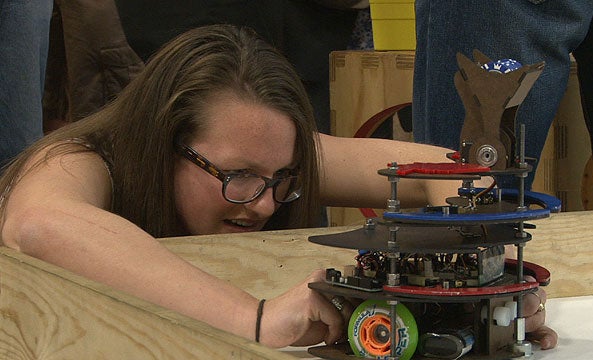|
View video here.
March 21, 2012
Stanford robots clash in class finale
Amid a cheering audience, student robots faced off in a "mechatronics" class showdown. In a nod to the political season, the autonomous machines raced to transport poker chips for Michelle Botman or Team Robama. By Steve Fyffe

A student performs last-minute preparations on her robot. (Photo: Steve Fyffe / Stanford News Service) It's not often that a class final attracts hundreds of cheering spectators. But it happened last week when 60 students gathered around a custom-built stage, about the size and shape of a Ping-Pong table, to pit their robotic creations against each other in the annual showdown that marks the end of the Introduction to Mechatronics course.
"Where else do you have engineers working on something surrounded by people cheering?" said mechanical engineering Professor Tom Kenny.
The competition has become a rite of passage for mechanical engineering students, who spend a quarter learning how to build a robot from the ground up.
"They've spent the first six weeks learning how to program the microprocessor, learning how to connect it to sensors, to motors, to other systems, and piece-by-piece learn all of the elements of a robot," Kenny said.
"And they've spent the last three weeks designing and building the chassis, selecting the wheels, picking motors, building circuits, writing software and putting it all together."
Kenny and his colleagues devise a new game each year to test the students' robots. Friends and family are invited to watch the show.
Designing a crowd-pleaser
"We have learned over the years about what pleases a crowd," said Matt Ohline, a consulting associate professor who co-teaches the class.
The bitterly fought Republican presidential primary provided the inspiration for this year's game, which was called "$uper PAC Monday." Each robot was loaded with poker chips, and then the autonomous machines had two minutes to deposit as many chips as possible into five bins, which were built on teeter-totters.
"Seeing these seesaws tilting back and forth as robots scurry from one point to another and deposit poker chips … that's going to be a pretty exciting thing to watch," Ohline said during final preparations for the event.
Each robot had its own unique design and strategy. One had arms that swung out from its body, dispensing three tokens at a time into three separate bins. Others relied on speed to fill the bins as quickly as possible. Sensors and infrared beacons helped guide the robots.
Hundreds of onlookers cheered as the competition unfolded before a standing-room audience inside the Peterson Engineering Laboratory. They moaned like fans at a sporting match when their favorite robots malfunctioned, dumping chips all over the table or spinning out of control.
It was the kind of exciting and encouraging atmosphere that Kenny hopes will inspire the next generation of mechanical engineers. However, he said, his class was more than just fun and games. It was intended to teach students the skills they will need in the workplace, where mechanical engineers are required to work on products that increasingly incorporate software and electronics.
"In most of these products there's some electronics, there's some mechanics and there's some computer science," Kenny said.
"And when you need a team of people to build those entire products, you need those individual disciplines, and someone has to be in charge. And what we find is students that have had a class like this tend to be the leaders of those teams."
A popular class
Students who had been watching those trends were eager to take the class.
"For me it seemed like this was the space where the future and cutting-edge stuff in mechanical engineering can be used," said Aaron Frankl.
"Now with electronic components becoming so cheap, it just seems like a must-take class. I just think it's really the way everything is going, so I wouldn't want to miss that boat."
Kelly Johnson said she hoped the class would give her the skills and confidence to take on a leadership role after she graduates to the workforce.
"Everything nowadays, even if it's mechanical, is somehow tied to different electrical components," Johnson said.
"So it's nice to be able to see the whole picture. Even if you won't be doing it all of the time, you can kind of understand what those other people at the table are doing when you pull together a full project."
After 12 rounds of eliminations among robots with names like Bit Romney and Tron Paul, the competition came down to a final run-off between Michelle Botman and Team Robama. Botman was the ultimate winner, by a razor-thin one-point margin.
The audience cheered enthusiastically as the winning team members hugged and posed for photos. Before the applause died down, Kenny had one last thing to say to the crowd.
"This proves that engineering can be fun."
Nora Sweeny in Mechanical Engineering contributed to this report.
-30-
|